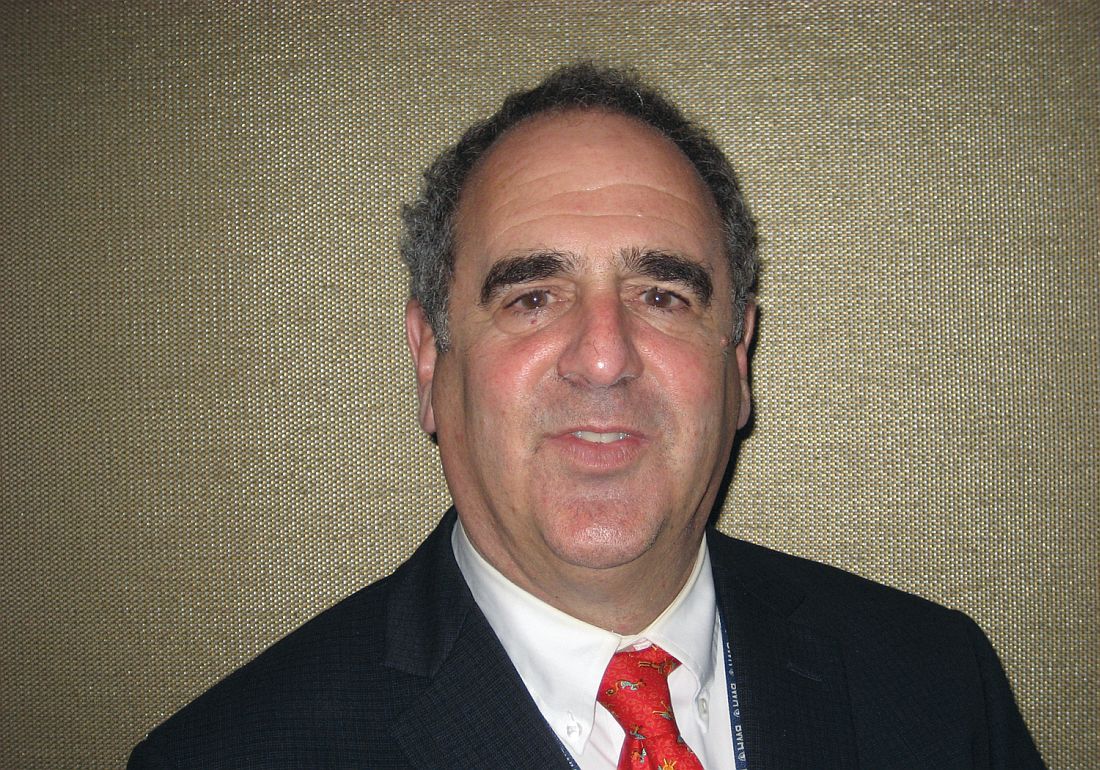User login
Prescribing rheumatoid arthritis patients a biologic agent rather than triple therapy, when they fail to respond adequately to methotrexate, costs more than half a million dollars per quality-adjusted life year gained over a lifetime but provides only a minimal health benefit beyond triple therapy, according to a report published online May 30 in Annals of Internal Medicine.
The evidence is clear that triple therapy using sulfasalazine, hydroxychloroquine, and methotrexate is at least as effective as methotrexate plus an anti–tumor necrosis factor biologic (etanercept, adalimumab, infliximab, golimumab, or certolizumab pegol). Nevertheless, few RA patients are transitioned to triple therapy before escalating to biologics. This occurred in only 2.5% of patients in one Veterans Affairs study, said Nick Bansback, PhD, of the University of British Columbia and St. Paul’s Hospital, Vancouver, and his associates.
Dr. Bansback and his colleagues performed a cost-effectiveness study of proceeding directly to etanercept when RA fails to respond to methotrexate, using data from the Rheumatoid Arthritis Comparison of Active Therapies (RACAT) trial. The RACAT study, a large international, randomized, double-blind trial, confirmed the clinical noninferiority of triple therapy versus etanercept plus methotrexate. In their analysis, Dr. Bansback and his associates calculated the costs and QALYs for both treatment strategies for 324 RACAT participants.
Switching directly to etanercept-methotrexate instead of triple therapy provided only a marginal advantage in QALYs, a difference of only 0.004 QALY over 24 weeks of treatment (0.358 with etanercept-methotrexate vs. 0.353 with triple therapy) and of only 0.016 QALY over 48 weeks of treatment (0.743 with etanercept-methotrexate vs. 0.726 with triple therapy). The associated costs were $11,295 for 24 weeks of etanercept-methotrexate, vs. $343 for 24 weeks of triple therapy, and $19,634 for 48 weeks of etanercept-methotrexate, vs. $3,680 for 48 weeks of triple therapy.
“The resultant ICER [incremental cost-effectiveness ratio] for first-line etanercept-methotrexate, vs. triple therapy, was $2.7 million per QALY gained over 24 weeks,” the investigators said (Ann Intern Med. 2017 May 29. doi: 10.7326/M16-0713).
When they extrapolated the data to determine the cost-effectiveness of the two treatment strategies over the course of the average patient’s lifetime, the model predicted an ICER of $521,520 per QALY gained for etanercept-methotrexate instead of triple therapy. These findings remained robust in numerous sensitivity and scenario analyses. For example, when the model assumed that radiographic and quality of life benefits of triple therapy were far lower than observed in the RACAT trial and far lower than what has been reported in the literature and that the tolerability of triple therapy was far worse than observed in the RACAT trial and reported in the literature, switching to etanercept-methotrexate instead of triple therapy still predicted an ICER of $350,000 per QALY per patient.
All of these ICERs far exceed the standard cost-effectiveness acceptability threshold ICER of $100,000 per QALY, Dr. Bansback and his associates noted.
This study demonstrates the substantial cost savings of prescribing triple therapy before a biologic. It shows that “for every patient who tries triple therapy before a biologic, payers will save an average of $78,000 over the patient’s lifetime, and most of the savings will accrue within the first 10 years,” the investigators wrote.
“Patients who receive triple therapy before a biologic will miss out on a benefit of approximately 0.15 QALY over their lifetime or a benefit of approximately 0.05 HAQ [Health Assessment Questionnaire] point at any point in time. To put these numbers in perspective, total hip arthroplasty in a patient with osteoarthritis who is approximately the same age as an average patient with RA provides an additional 6.9 QALYs. In terms of HAQ score, only differences greater than 0.2 points are considered minimally important to patients,” Dr. Bansback and his associates wrote.
Changing health care policy to require, rather than to just recommend, that triple therapy be prescribed before biologics would save millions of dollars in health care expenditures, they added.
This study was supported by the U.S. Department of Veterans Affairs Office of Research and Development, the Canadian Institutes for Health Research, the National Institutes of Health, and the American Recovery and Reinvestment Act. Dr. Bansback reported having no relevant financial disclosures. His associates reported ties to numerous industry sources.
The findings of Bansback et al., consistent with those of several other researchers, indicate that patients who have RA and no contraindications to triple-conventional, disease-modifying antirheumatic drug therapy should use therapy instead of biologics as the next regimen if methotrexate alone fails to control symptoms and radiographic progression.
Elena Losina, PhD, and Jeffrey N. Katz, MD, are at Brigham and Women’s Hospital in Boston. They disclosed having no conflicts of interest. Dr. Losina and Dr. Katz made these remarks in an editorial accompanying Dr. Bansback’s report (Ann Intern Med. 2017 May 29. doi: 10.7326/M17-1176).
The findings of Bansback et al., consistent with those of several other researchers, indicate that patients who have RA and no contraindications to triple-conventional, disease-modifying antirheumatic drug therapy should use therapy instead of biologics as the next regimen if methotrexate alone fails to control symptoms and radiographic progression.
Elena Losina, PhD, and Jeffrey N. Katz, MD, are at Brigham and Women’s Hospital in Boston. They disclosed having no conflicts of interest. Dr. Losina and Dr. Katz made these remarks in an editorial accompanying Dr. Bansback’s report (Ann Intern Med. 2017 May 29. doi: 10.7326/M17-1176).
The findings of Bansback et al., consistent with those of several other researchers, indicate that patients who have RA and no contraindications to triple-conventional, disease-modifying antirheumatic drug therapy should use therapy instead of biologics as the next regimen if methotrexate alone fails to control symptoms and radiographic progression.
Elena Losina, PhD, and Jeffrey N. Katz, MD, are at Brigham and Women’s Hospital in Boston. They disclosed having no conflicts of interest. Dr. Losina and Dr. Katz made these remarks in an editorial accompanying Dr. Bansback’s report (Ann Intern Med. 2017 May 29. doi: 10.7326/M17-1176).
Prescribing rheumatoid arthritis patients a biologic agent rather than triple therapy, when they fail to respond adequately to methotrexate, costs more than half a million dollars per quality-adjusted life year gained over a lifetime but provides only a minimal health benefit beyond triple therapy, according to a report published online May 30 in Annals of Internal Medicine.
The evidence is clear that triple therapy using sulfasalazine, hydroxychloroquine, and methotrexate is at least as effective as methotrexate plus an anti–tumor necrosis factor biologic (etanercept, adalimumab, infliximab, golimumab, or certolizumab pegol). Nevertheless, few RA patients are transitioned to triple therapy before escalating to biologics. This occurred in only 2.5% of patients in one Veterans Affairs study, said Nick Bansback, PhD, of the University of British Columbia and St. Paul’s Hospital, Vancouver, and his associates.
Dr. Bansback and his colleagues performed a cost-effectiveness study of proceeding directly to etanercept when RA fails to respond to methotrexate, using data from the Rheumatoid Arthritis Comparison of Active Therapies (RACAT) trial. The RACAT study, a large international, randomized, double-blind trial, confirmed the clinical noninferiority of triple therapy versus etanercept plus methotrexate. In their analysis, Dr. Bansback and his associates calculated the costs and QALYs for both treatment strategies for 324 RACAT participants.
Switching directly to etanercept-methotrexate instead of triple therapy provided only a marginal advantage in QALYs, a difference of only 0.004 QALY over 24 weeks of treatment (0.358 with etanercept-methotrexate vs. 0.353 with triple therapy) and of only 0.016 QALY over 48 weeks of treatment (0.743 with etanercept-methotrexate vs. 0.726 with triple therapy). The associated costs were $11,295 for 24 weeks of etanercept-methotrexate, vs. $343 for 24 weeks of triple therapy, and $19,634 for 48 weeks of etanercept-methotrexate, vs. $3,680 for 48 weeks of triple therapy.
“The resultant ICER [incremental cost-effectiveness ratio] for first-line etanercept-methotrexate, vs. triple therapy, was $2.7 million per QALY gained over 24 weeks,” the investigators said (Ann Intern Med. 2017 May 29. doi: 10.7326/M16-0713).
When they extrapolated the data to determine the cost-effectiveness of the two treatment strategies over the course of the average patient’s lifetime, the model predicted an ICER of $521,520 per QALY gained for etanercept-methotrexate instead of triple therapy. These findings remained robust in numerous sensitivity and scenario analyses. For example, when the model assumed that radiographic and quality of life benefits of triple therapy were far lower than observed in the RACAT trial and far lower than what has been reported in the literature and that the tolerability of triple therapy was far worse than observed in the RACAT trial and reported in the literature, switching to etanercept-methotrexate instead of triple therapy still predicted an ICER of $350,000 per QALY per patient.
All of these ICERs far exceed the standard cost-effectiveness acceptability threshold ICER of $100,000 per QALY, Dr. Bansback and his associates noted.
This study demonstrates the substantial cost savings of prescribing triple therapy before a biologic. It shows that “for every patient who tries triple therapy before a biologic, payers will save an average of $78,000 over the patient’s lifetime, and most of the savings will accrue within the first 10 years,” the investigators wrote.
“Patients who receive triple therapy before a biologic will miss out on a benefit of approximately 0.15 QALY over their lifetime or a benefit of approximately 0.05 HAQ [Health Assessment Questionnaire] point at any point in time. To put these numbers in perspective, total hip arthroplasty in a patient with osteoarthritis who is approximately the same age as an average patient with RA provides an additional 6.9 QALYs. In terms of HAQ score, only differences greater than 0.2 points are considered minimally important to patients,” Dr. Bansback and his associates wrote.
Changing health care policy to require, rather than to just recommend, that triple therapy be prescribed before biologics would save millions of dollars in health care expenditures, they added.
This study was supported by the U.S. Department of Veterans Affairs Office of Research and Development, the Canadian Institutes for Health Research, the National Institutes of Health, and the American Recovery and Reinvestment Act. Dr. Bansback reported having no relevant financial disclosures. His associates reported ties to numerous industry sources.
Prescribing rheumatoid arthritis patients a biologic agent rather than triple therapy, when they fail to respond adequately to methotrexate, costs more than half a million dollars per quality-adjusted life year gained over a lifetime but provides only a minimal health benefit beyond triple therapy, according to a report published online May 30 in Annals of Internal Medicine.
The evidence is clear that triple therapy using sulfasalazine, hydroxychloroquine, and methotrexate is at least as effective as methotrexate plus an anti–tumor necrosis factor biologic (etanercept, adalimumab, infliximab, golimumab, or certolizumab pegol). Nevertheless, few RA patients are transitioned to triple therapy before escalating to biologics. This occurred in only 2.5% of patients in one Veterans Affairs study, said Nick Bansback, PhD, of the University of British Columbia and St. Paul’s Hospital, Vancouver, and his associates.
Dr. Bansback and his colleagues performed a cost-effectiveness study of proceeding directly to etanercept when RA fails to respond to methotrexate, using data from the Rheumatoid Arthritis Comparison of Active Therapies (RACAT) trial. The RACAT study, a large international, randomized, double-blind trial, confirmed the clinical noninferiority of triple therapy versus etanercept plus methotrexate. In their analysis, Dr. Bansback and his associates calculated the costs and QALYs for both treatment strategies for 324 RACAT participants.
Switching directly to etanercept-methotrexate instead of triple therapy provided only a marginal advantage in QALYs, a difference of only 0.004 QALY over 24 weeks of treatment (0.358 with etanercept-methotrexate vs. 0.353 with triple therapy) and of only 0.016 QALY over 48 weeks of treatment (0.743 with etanercept-methotrexate vs. 0.726 with triple therapy). The associated costs were $11,295 for 24 weeks of etanercept-methotrexate, vs. $343 for 24 weeks of triple therapy, and $19,634 for 48 weeks of etanercept-methotrexate, vs. $3,680 for 48 weeks of triple therapy.
“The resultant ICER [incremental cost-effectiveness ratio] for first-line etanercept-methotrexate, vs. triple therapy, was $2.7 million per QALY gained over 24 weeks,” the investigators said (Ann Intern Med. 2017 May 29. doi: 10.7326/M16-0713).
When they extrapolated the data to determine the cost-effectiveness of the two treatment strategies over the course of the average patient’s lifetime, the model predicted an ICER of $521,520 per QALY gained for etanercept-methotrexate instead of triple therapy. These findings remained robust in numerous sensitivity and scenario analyses. For example, when the model assumed that radiographic and quality of life benefits of triple therapy were far lower than observed in the RACAT trial and far lower than what has been reported in the literature and that the tolerability of triple therapy was far worse than observed in the RACAT trial and reported in the literature, switching to etanercept-methotrexate instead of triple therapy still predicted an ICER of $350,000 per QALY per patient.
All of these ICERs far exceed the standard cost-effectiveness acceptability threshold ICER of $100,000 per QALY, Dr. Bansback and his associates noted.
This study demonstrates the substantial cost savings of prescribing triple therapy before a biologic. It shows that “for every patient who tries triple therapy before a biologic, payers will save an average of $78,000 over the patient’s lifetime, and most of the savings will accrue within the first 10 years,” the investigators wrote.
“Patients who receive triple therapy before a biologic will miss out on a benefit of approximately 0.15 QALY over their lifetime or a benefit of approximately 0.05 HAQ [Health Assessment Questionnaire] point at any point in time. To put these numbers in perspective, total hip arthroplasty in a patient with osteoarthritis who is approximately the same age as an average patient with RA provides an additional 6.9 QALYs. In terms of HAQ score, only differences greater than 0.2 points are considered minimally important to patients,” Dr. Bansback and his associates wrote.
Changing health care policy to require, rather than to just recommend, that triple therapy be prescribed before biologics would save millions of dollars in health care expenditures, they added.
This study was supported by the U.S. Department of Veterans Affairs Office of Research and Development, the Canadian Institutes for Health Research, the National Institutes of Health, and the American Recovery and Reinvestment Act. Dr. Bansback reported having no relevant financial disclosures. His associates reported ties to numerous industry sources.
FROM ANNALS OF INTERNAL MEDICINE
Key clinical point:
Major finding: For every RA patient who tries triple therapy before a biologic, payers will save an average of $78,000 over the patient’s lifetime without sacrificing their health or quality of life.
Data source: A cost-effectiveness analysis using data from 324 participants in an international, randomized, double-blind trial.
Disclosures: This study was supported by the U.S. Department of Veterans Affairs Office of Research and Development, the Canadian Institutes for Health Research, the National Institutes of Health, and the American Recovery and Reinvestment Act. Dr. Bansback reported having no relevant financial disclosures. His associates reported ties to numerous industry sources.


